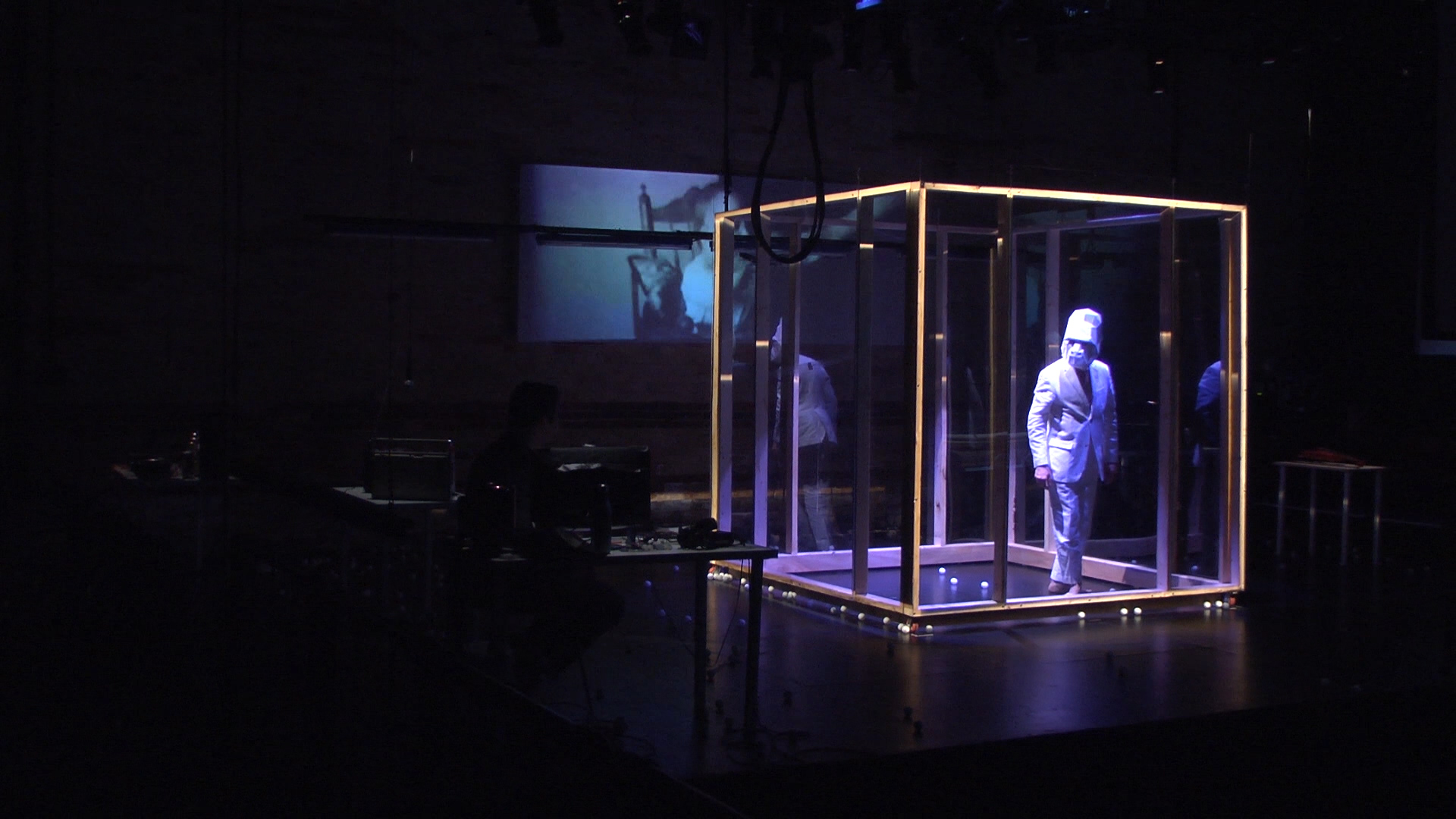Apes, Zen Buddhism, and John Cage
We flattened out the theatre, taking away the majority of its seating, and devised a central laboratory-like environment that the audience can observe from the outside before entering. Inside the playing space, an intimate audience of ninety will sit on one of four sides looking in. Behind each seating section is a large projection screen. As the viewer looks across the room, their eyes will pass over multiple layers of apparatus. The first contains an array of fluorescent tubes attached to four steel battens hanging at various heights. The next displays lighting, sound, and video operating equipment, as well as standalone “instruments”—radios, metal objects, a kettle, ping pong balls, water, a theremin, a piano. In the middle of the room sits an eight-foot steel cage made of glass, the perfect size for a human. The goal was to make a space that is immersive and autonomous at the same time; a place for experience and for meditation.

An early sketch of the Cage set, by Lorenzo Savoini
Before stepping into the theatre together, Diego Matamoros, Richard Feren, and I spent some time at the zoo. Diego, a curious actor, has been meditating on gorillas for years, studying their movement, their communication, and their gift for living masterfully in the present. That day at the zoo, all three of us observed these primates caged in behind metal and glass.
That’s when the metaphor began to come into focus. Back in our lives, we started to see cages everywhere: societal, political, and so on. For us, the most fascinating was the human cage. We began to talk about how outside of us is the physical world bound by time, space, and matter, and inside of us exists a boundless reality filled with the potential of our imagination. Between these two truths exists a tension. This became central to our exploration.
When Diego approached Richard and me about working on this solo show, he said he wanted to explore three of his long-time curiosities: apes (which is what brought us to the zoo), Zen Buddhism, and the practice of avant-garde composer John Cage. With these distinct ideas in mind, we entered a theatre laboratory, spending about six weeks in there over the course of six months. What came to be was an experiential meditation on space, time, memory, and the human animal.

Video still from Cage in development at Soulpepper. Photo by Daniel Malavasi
The interest in John Cage went far beyond the thematic connection of his name. We were intrigued by his methodology of chance operations. Cage sought a balance between the rational and the irrational, allowing random events to function within the context of a controlled system. He has said his favourite sound was traffic, its “music” completely determined by random human events. Encouraged by this, we explored chance encounters between our various disciplines: Diego as an actor, Richard as a sound designer, me as a production designer.
Like a piece of music, we divided the production into a series of movements, each the same length of time: four minutes and thirty-three seconds. This timeframe gave us structure, kind of like a cage. Within it, we played with performance, lighting, video projection, objects, text, space, and sound, each intersecting and juxtaposing with the others to create an abstract collage of experience.
But we didn’t do everything at once. We applied a process involving chance to determine what content would be used in which movement, and how often that content might shift and change. When the four minutes and thirty-three seconds ran out, a bell would ring and we would move onto the next movement, regardless of where we were in our individual offerings.
Eventually, in our experimentation, themes and motifs began to crop up, which we built on to create a show. Our theatre laboratory became a kind of meeting place between the accidental and the intentional.
On this strange little journey, the guiding principles of Zen have been the glue holding the structure together.
Do one thing at a time.
Do it slowly and deliberately.
Do it completely.
Do less.
Put space between things.
Develop rituals.
Designate time for certain things.
Zen emphasizes rigorous self-control, meditation, observation, presences, awareness, and, most importantly, a practice that points out the illusion of time. There is no past and no future. There is only now. The gorillas at the zoo seem to practice this with grace. It is also something that permeated into John Cage’s practice.
The same could be said for our work. I believe an awareness of one’s consciousness is part of the experience of watching Cage. There’s as much a possibility of being bored as there is being exhilarated. But the opportunity to just be present with the offering—to experience the space between the notes—exists, and Zen plays a role in that. Of course, the theatre animal in us wants to “bite cues,” move faster, and make great efforts to entertain, but these instincts are antithetical to what we are investigating. As John Cage once said, “If something is boring after two minutes, try it for four. If still boring, then eight. Then sixteen. Then thirty-two. Eventually one discovers that it is not boring at all.”

As a designer, it’s rare to have this degree of authorship on a production. I can tell you this is unlike anything Soulpepper has produced before, or anything I have ever made before, and that’s both exhilarating and unnerving. On opening night, a designer’s work is usually done; but with Cage I will begin another stage of the process as designer-performer. Both Richard and I will be actively applying our disciplines at every performance, and if our experience up till now tells us anything, this piece will never be finished. Continuing to be with it after opening means we can keep responding and changing to a work that seems to take us wherever it wants to go.
None of us is trying to “say” something with this work. Cage has become a subjective, mysterious experience that requires the audience’s imagination and interpretation to form meaning. We wanted to create puzzle pieces the audience can assemble with their imaginations, awakening their senses and freeing their mind. What we are making may belong more in a gallery then on the stage, but our experiment is to find out if there is a meeting place between performance art and theatre.
Experience the world Lorenzo, Diego, and Richard created; Cage is on at Soulpepper from March 11 to March 25.
For tickets or more information, click herehttps://www.youtube.com/watch?v=ATyAgZtHbn8&t=6s









Comments